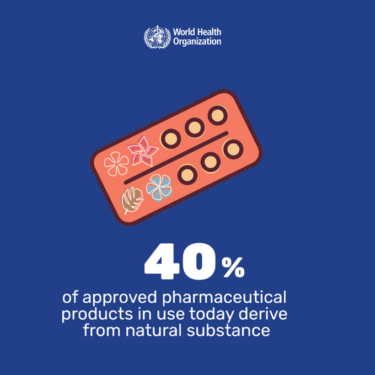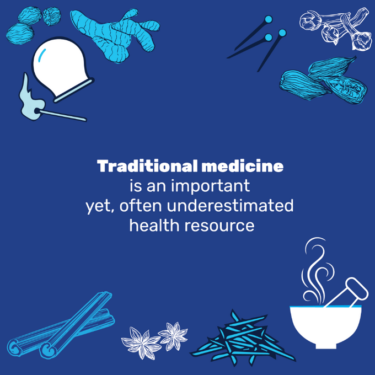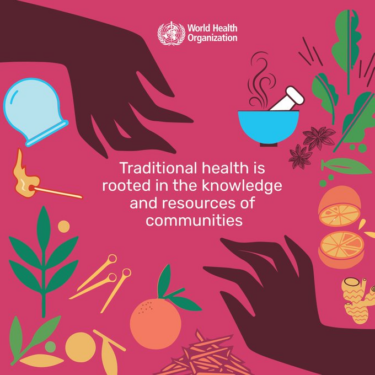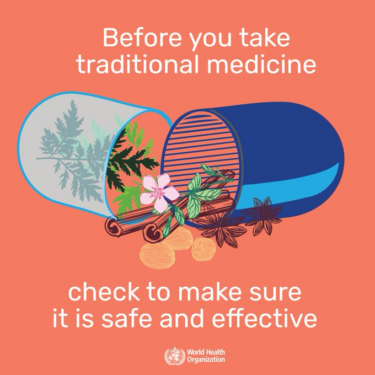A couple of weeks ago, on the 12th August, the World Health Organisation published a series of tweets discussing traditional medicine, and its importance. The thread was part of their communication strategy for, as they describe it, their first ever high-level global summit on traditional medicine to explore evidence base and opportunities to accelerate health for all, which took place in India on the 17th and 18th August. The aim of the summit was to:
explore the role of traditional, complementary, and integrative medicine in addressing pressing health challenges and driving progress in global health and sustainable development.
We’ll get to the summit and their main statements in a moment, but as most people found this on Twitter, let’s start there. Their 11-tweet thread started with:
#TraditionalMedicine has been at the frontiers of medicine & science laying the foundation for conventional medical texts. #DYK: Nearly 40% of pharmaceutical products have a natural product base, incl.:
💊 aspirin
💊 artemisinin
💊 contraceptive pills
💊 childhood cancer treatments
They included some graphics pointing out that Aspirin came from White Willow Bark, the Contraceptive Pill came from Wild Yam Roots, Childhood Cancer Medicine was derived from Rosy Periwinkle and the Antimalaria Pill was derived from Sweet Wormwood. All of which is true enough. They also included a graphic that read:

40% of approved pharmaceutical products in use today derive from natural substance
This may well be true – I checked, and couldn’t find any reference online for that figure – but it’s also not all that remarkable. What else could they be derived from? It’s almost a surprise that it’s as low as 40% – often, chemicals that occur in nature are studied, and if they are found to be useful, synthesised. So they’re still derived from nature.
The final graphic was more problematic:
Traditional Medicine is an important and yet often underestimated health resource

Here, I’m not sure I agree… depending on what is meant by ‘traditional medicine’. Similarly, is it true that traditional medicine has been at the frontiers of medicine and laid the foundations for today? That very much depends on what you count as traditional medicine. People chewing willow bark laid the foundations for aspirin use today, but people doing bloodletting rituals to drain the humours have offered us effectively nothing of long-lasting value.
The categorisation is key here, and is perhaps also key as to why so many people took issue with the WHO’s thread. Because people didn’t take issue with the posts explaining how Tu Youyou, in 1969, developed an antimalarial drug from a plant that had been used for some time in areas of China where malaria was prevalent, nor the one about Dr Luis Miramontes stabilising a protein from the Mexican Yam in order to create the contraceptive pill.
But they did take issue with the fourth tweet in the thread:
For millions of people around the world #TraditionalMedicine is their first stop for health and well-being. Which of these have you used?
– Acupuncture
– Ayurveda
– Herbal medicine
– Homeopathy
– Naturopathy
– Osteopathy
– Traditional Chinese medicine
– Unani medicine.
The first half of this message is true – millions of people do turn to traditional medicine first when it comes to health, even though they shouldn’t. Technically, the WHO isn’t actually saying they should, just that they do – but it’s saying so in language that’s unclear enough as to sound like an endorsement. And then they list out examples of traditional medicine… half of which are not remotely traditional. Homeopathy is from the 18th century, osteopathy the 19th century, and Traditional Chinese Medicine essentially the 1950s.
TCM is of particular concern there, because in the tweet about Tu Youyou inventing an antimalarial, the WHO claimed she turned to TCM for the answer. TCM which, by that point, had been established for less than two decades.
So, does the WHO think homeopathy is ‘traditional’? Either it does, which is worrying, or it’s happy to blur the lines as part of its promotion of a summit in India – which is even more worrying, given how much harm is done by homeopathic medicines in India. It’s easy to see why this tweet went viral, getting five million views, compared to the few hundred thousand for each of the other tweets. It even attracted a community note, clarifying:
Homeopathy, osteopathy & naturopathy are not traditional medicine, but should be described as pseudoscience as they were are invented in countries/times where/when modern science was already developed. Also, the contemporary used form of acupuncture has modern roots.
What is going on at the WHO, you might wonder? The rest of the thread, from that point, starts to make things clearer, albeit giving it one last shot of muddy language before they get to that point:
#TraditionalMedicine is rooted in Indigenous knowledges & natural resources of communities. It has been an integral resource for health in households for centuries.
WHO works to strengthen the evidence base of traditional medicine, enhancing its safety & efficacy
WHO’s #TraditionalMedicine programme aims to build solid evidence base for policies and standards on traditional medicine practices and products, helping countries integrate it into their health systems & regulate its quality. Here’s how: https://bit.ly/3DMniD1

It’s reasonably true to say that traditional medicine is rooted in indigenous knowledge, in the sense that people who have lived closest to the plants that contain beneficial medical proteins and chemical compounds are better able to recognise them than an outsider coming along with their size 11 boots and Pith helmets. But that indigenous knowledge on its own isn’t enough to confirm those remedies are effective or safe – there are plenty of natural remedies that aren’t good for us, or that don’t work well, or that don’t interact well with other remedies. It’s important that we respect other cultures, but part of that respect also means applying the kind of scrutiny and rigour we’d expect our treatments to go through – otherwise, you end up in a situation where herbal remedies can be sold in Boots with “traditional medicine without therapeutic indication” written on the side.
But, once we get past the slightly troubling nod towards ‘other ways of knowing’, we have the WHO explaining that they’re looking to enhance the safety and efficacy of traditional medicine, strengthen the evidence base, and regulate its quality. Those are good things, if they’re carried out correctly – if ‘strengthening the evidence base’ means leaving behind the remedies for which there is no good evidence of efficacy, and if ‘regulating its quality’ means protecting the public from things that can only be harmful.
If, in doing so, they find good, reliable, replicable and robust evidence for some treatments that have hitherto been considered traditional or complementary, that can only be a good thing for real medicine… if it works. But it has to be proven to work. Once it’s proven to work, it shouldn’t matter if it’s conventional, traditional, synthetic, or beamed down by aliens.
Then there’s the seventh tweet of the thread:
If you’re using #TraditionalMedicine, here are 5 safety checks:
➡️ Talk to your health practitioner before taking any product
➡️ Check the source of information & the research
➡️ Check if the source lists both advantages & disadvantages
➡️ Beware of exaggerated promises
➡️ Do not delay seeing your health practitioner
Before you take traditional medicine, check to make sure it is safe and effective.

That one didn’t draw public ire, because it’s exactly what we would say about alternative medicine. Seeking the advice of a health practitioner before embarking on an alternative medical treatment is important – as long as, of course, the health practitioner is qualified, and is not just the traditional healer who is trying to sell the remedy in question.
It’s also crucial to be sure the remedy is safe and effective before taking it – which, for the vast majority of the alternative medicine field, will mean not taking it – but that check does rely on being able to access good quality information or expertise on how safe and effective something is. That might well be doable in countries with a good healthcare system, but much harder if you’re somewhere where you might not have easy access to a doctor – like remote parts of China, rural India, or (for those who haven’t the money to pay) the United States.
The WHO do have access to doctors, though, and their thread includes an interview with Dr Susan Wieland from the Cochrane Collaboration, who is there to “explain how to safely use #TraditionalMedicine”. In her video she explains that natural doesn’t mean safe, because some herbs are unsafe, especially if you have certain medications or conditions. And that some things are safe at lower doses but not a higher dose.
She tells us you can’t always trust the label or trust what’s in the remedy, and you should try to make sure you can trust the producer, but if you have something serious, like cancer, make sure you use effective treatments. You can even do that alongside yoga and nutrition if you like, but that can’t be instead of seeing a doctor who has expertise. If you’re going to do traditional practices, integrate them with modern medicine, to have safe and effective treatments for your condition. All of this is very sound advice, delivered in a way as to make it approachable to people who might switch off if they hear it coming from someone who has just told them all traditional medicine is dangerous quackery.
The WHO then feature an interview with British long jumper Abigail Irozuru, who explains that she uses yoga meditation alongside medicine in order to perform at her best, before wrapping up by explaining that embracing traditional medicine must be based on science, to avoid patient harm and ensure safe, effective and quality health care for all, and that traditional medicine practices and products have to pass the same level of scrutiny as modern pharmaceuticals. Which, again, is fine and exactly what we’d want them to say.
Beyond Twitter
This Twitter engagement was primarily an exercise in promoting the WHO’s web pages around the summit, and the topic more broadly. One of the first links in the thread goes to the statement from the 10th of August titled “Traditional medicine has a long history of contributing to conventional medicine and continues to hold promise”. This title itself is not a good start: the history may be there, in the specific and fairly limited ways you can cherry pick some good case studies from, but it is debatable to what degree it continues to hold much promise.
It continues in an even worse vein, with the opening paragraph claiming that
for centuries across countries, people have turned to traditional healers, home remedies and ancient medicinal knowledge to address their health and well-being needs”
Yes, people have turned to those healers, but often that was in the absence of something that could actually help, and involved getting something that did not help. And the very next sentence:
According to the WHO Global Report on Traditional and Complementary Medicine (2019), various systems of traditional medicine being used around the world include acupuncture, herbal medicines, indigenous traditional medicine, homeopathy, traditional Chinese medicine, naturopathy, chiropractic, osteopathy, ayurvedic and Unani medicine.
Acupuncture, in a form quite unlike today, may well be ancient – but there’s also no evidence that it works (not even the former, weak evidence that it’s as good as an aspirin for lower back pain), and there’s no mechanism by which it could work, because meridian lines aren’t real and Chi doesn’t exist. Homeopathy is 250 years old, osteopathy 140 years old, naturopathy and chiropractic around 125 years old, and Traditional Chinese Medicine – including the modern form of acupuncture – is 70 years old. Of the various systems of traditional medicine identified by the WHO, half of them essentially aren’t any older than conventional medicine. Once you take out herbal medicine, and it’s contributions to some of the foundations of conventional pharmaceuticals, you’re left with not a lot else, beyond a lot of things that we know right now are causing harm to people’s health through tainted products and unidentified contraindications.
Under the heading “Tapping nature and indigenous knowledge to advance modern medicine”, the WHO repeat the story of Tu Youyou and her Nobel Prize winning discovery of the antimalarial, this time with a little more context:
After testing – unsuccessfully — over 240 000 compounds for use in antimalarials, Chinese scientist Tu Youyou, head of the Project 523 to discover a cure for chloroquine-resistant malaria, turned to traditional Chinese medical literature for clues. There, she and her team found a reference to sweet wormwood to treat intermittent fevers.
This reads a little oddly, as it makes it sound like Tu tried over 240,000 different compounds, before turning to TCM – in actuality, scientists around the world experimented with those different chemicals, but Tu had the idea of gathering prescriptions from TCM practitioners, and testing their recommendations. She collated 2000 recipes, to form 380 extracts, which her team tested scientifically. One of those extracts included artemisinin, which the team extracted, synthesised, and put in a pill, and found that it worked.
It isn’t clear what happened to the other 1,999 recipes the TCM practitioners gave Tu, but this sounds rather like a cherry-picked anecdote being used to support TCM, when it could just as readily be used to highlight that indigenous people had figured out that a plant could have some medicinal benefit – not a controversial idea – but that knowledge needed to be rigorously tested before we could rely on it. The front line defence against malaria today isn’t a low-temperature tea of sweet wormwood, or an appointment with a TCM practitioner, just as we aren’t told to chew willow back when we have a headache.
That isn’t, however, to say that the contributions of older stores of information were worthless – medicine only came to willow bark and sweet wormwood because of those older anecdotes, after all. And as the WHO point out, yoga can be good for types of chronic pain and back pain – not because there’s an energetic flow through our chakras, but because a degree light stretching is good for our body. We can keep up the older practice, if it turns out that it reliably works, but we shouldn’t venerate the proposed mechanisms if they’re wrong – any more than we should bend the knee to the idea of miasmas or that illness is derived from bad smells, now that we know pathogens and infections can cause both unpleasant odours and infections.
A flawed initiative?
The statements from the WHO are, at best, ham-fisted, and it’s concerning that they seem to have little understanding of what is and isn’t a traditional medicine, and what role historic knowledge has to play. It is absolutely reasonable and valid to celebrate the things that our ancestors – or, indeed, anyone’s ancestors – figured out, even if they weren’t sure, or weren’t correct, as to why those things worked. We stand on the shoulders of giants; we are no smarter than those who came before us, we just started further along the line of knowledge and discovery, because of the strides and advances of our predecessors. We can and should respect that, without unquestioningly accepting everything that people used to believe, or imbuing “ancient” or “indigenous” knowledge with a special significance that puts it above fair and reasonable scrutiny.
There’s also perhaps a kernel, here, of something that might not actually be a bad initiative from the WHO, if it’s done robustly and rigorously: if what they are looking to do is to genuinely examine, test, and then (importantly) officially reject any traditional medicines that fail to meet the standard of safe and effective, that could actually be a powerful thing. Packaging that exercise up in a way that’s designed to be welcoming to people who do – for whatever reason – use those treatments is potentially a smart framing; there’s nothing to be gained from alienating the very audience who might need to hear what you have to say.
However, there are still serious reservations. Their definition of “traditional” is so broad and so far wide of the mark, and raises questions as to is driving this initiative, and how effective they already believe alt-med to be. Inquiry can only ever be as good and as robust as the inquirer.
It’s encouraging that the WHO make it clear – both in their thread and in the FAQs on their site – that ‘traditional medicine’ is not automatically safe, that it can be very dangerous, and that you should not trust it without good cause. They argue that users need to be better informed about ‘traditional’ medicine (though I’d argue the WHO could stand to be better informed as to which systems are actually traditional), and that people need to be more aware of the risk of contamination, allergies, drug interactions, and inexperienced or unqualified practitioners.
Finally, given some of the confusion from the WHO, and some of the language around the cherry-picked examples of traditional medicine success stories, it is hard not to worry that their stated goal of clarifying the evidence basis for various types of alternative medicine might itself be flawed. The world of alternative medicine research is filled with studies that have poor or no blinding, small sample sizes, biased analysis and over-stated conclusions – and that’s not even considering the studies that are outright fraudulent. If the WHO are so willing to accept at face value claims as to the historical contributions of traditional medicine to conventional healthcare, it’s hard to see that they’d be able to apply sufficient skepticism and criticism when faced with positive results from a poorly conducted study.
If we really want to honour ancestral wisdom and the knowledge of the ages, we do that by subjecting it to the kind of rigour we’d apply in any other field: by not patronisingly lowering the bar, we can pay true respect.


